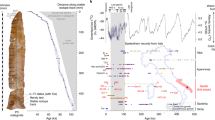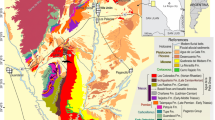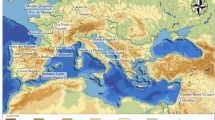Abstract
Attempts to place Palaeolithic finds within a precise climatic framework are complicated by both uncertainty over the radiocarbon calibration beyond about 21,500 14C years bp1 and the absence of a master calendar chronology for climate events from reference archives such as Greenland ice cores or speleothems2. Here we present an alternative approach, in which 14C dates of interest are mapped directly onto the palaeoclimate record of the Cariaco Basin by means of its 14C series3, circumventing calendar age model and correlation uncertainties, and placing dated events in the millennial-scale climate context of the last glacial period. This is applied to different sets of dates from levels with Mousterian artefacts, presumably produced by late Neanderthals, from Gorham’s Cave in Gibraltar: first, generally accepted estimates of about 32,000 14C years bp for the uppermost Mousterian levels4,5; second, a possible extended Middle Palaeolithic occupation until about 28,000 14C years bp6; and third, more contentious evidence for persistence until about 24,000 14C years bp6. This study shows that the three sets translate to different scenarios on the role of climate in Neanderthal extinction. The first two correspond to intervals of general climatic instability between stadials and interstadials that characterized most of the Middle Pleniglacial and are not coeval with Heinrich Events. In contrast, if accepted, the youngest date indicates that late Neanderthals may have persisted up to the onset of a major environmental shift, which included an expansion in global ice volume and an increased latitudinal temperature gradient. More generally, our radiocarbon climatostratigraphic approach can be applied to any ‘snapshot’ date from discontinuous records in a variety of deposits and can become a powerful tool in evaluating the climatic signature of critical intervals in Late Pleistocene human evolution.
This is a preview of subscription content, access via your institution
Access options
Subscribe to this journal
Receive 51 print issues and online access
$199.00 per year
only $3.90 per issue
Buy this article
- Purchase on Springer Link
- Instant access to full article PDF
Prices may be subject to local taxes which are calculated during checkout

Similar content being viewed by others
References
Reimer, P. J. et al. IntCal04 terrestrial radiocarbon age calibration, 0–26 cal kyr BP. Radiocarbon 46, 1029–1058 (2004)
Svensson, A. et al. The Greenland Ice Core Chronology 2005, 15–42 ka. Part 2: comparison to other records. Quat. Sci. Rev. 25, 3258–3267 (2006)
Hughen, K. et al. C-14 activity and global carbon cycle changes over the past 50,000 years. Science 303, 202–207 (2004)
Pettitt, P. B. & Bailey, R. M. in Neanderthals on the Edge (eds Stringer, C. B., Barton, R. N. E. & Finlayson, C.) 155–162 (Oxbow Books, Oxford, 2000)
Bronk Ramsey, C., Higham, T. F. G., Owen, D. C., Pike, A. W. G. & Hedges, R. E. M. Radiocarbon dates from the Oxford AMS System. Archaeometry Datelist 31. Archaeometry 44, 1–149 (2002)
Finlayson, C. et al. Late survival of Neanderthals at the southernmost extreme of Europe. Nature 443, 850–853 (2006)
Stringer, C. et al. in Neanderthals and Modern Humans in the European Landscape during the Last Deglaciation (eds van Andel, T. H. & Davies, W.) 233–240 (McDonald Institute Monographs, Cambridge, 2003)
Zilhão, J. Chronostratigraphy of the Middle-to-Upper Paleolithic transition in the Iberian peninsula. Pyrenae 37, 7–84 (2006)
Delson, E. & Harvati, K. Return of the last Neanderthal. Nature 443, 762–763 (2006)
Zilhão, J. & Pettitt, P. On the new dates for Gorham’s Cave and the late survival of Iberian Neanderthals. Before Farming [online version] 2006/3 article 3 〈http://www.waspress.co.uk/journals/beforefarming/journal_20063/ abstracts/index.php〉 (2006)
Jiménez-Espejo, F. J. et al. Climate forcing and Neanderthal extinction in Southern Iberia: insights from a multiproxy marine record. Quat. Sci. Rev. 26, 836–852 (2007)
Cacho, I. et al. Dansgaard–Oeschger and Heinrich event imprints in Alboran Sea paleotemperatures. Paleoceanography 14, 698–705 (1999)
Moreno, A. et al. Links between marine and atmospheric processes oscillating at millennial time-scale. A multi-proxy study of the last 50,000 yr from the Alboran Sea (Western Mediterranean Sea). Quat. Sci. Rev. 24, 1623–1636 (2005)
Pons, A. & Reille, M. The Holocene- and Upper Pleistocene pollen record from Padul (Granada, Spain), a new study. Palaeogeogr. Palaeoclimatol. Palaeoecol. 66, 243–263 (1988)
Sánchez Goñi, M. F. et al. Synchroneity between marine and terrestrial responses to millennial scale climatic variability during the last glacial period in the Mediterranean region. Clim. Dyn. 19, 95–105 (2002)
Combourieu-Nebout, N. et al. Enhanced aridity and atmospheric high-pressure stability over the western Mediterranean during the North Atlantic cold events of the past 50 k.y. Geology 30, 863–866 (2002)
Sepulchre, P. et al. H4 abrupt event and late Neanderthal presence in Iberia. Earth Planet. Sci. Lett. 258, 283–292 (2007)
Walker, M. J. C. et al. Isotopic ‘events’ in the GRIP ice core: a stratotype for the Late Pleistocene. Quat. Sci. Rev. 18, 1143–1150 (1999)
Meese, D. A. et al. The Greenland Ice Sheet Project 2 depth-age scale: Methods and results. J. Geophys. Res. 102, 26411–26423 (1997)
Siddall, M. et al. Sea-level fluctuations during the last glacial cycle. Nature 423, 853–858 (2003)
Peltier, W. R. & Fairbanks, R. G. Global glacial ice volume and Last Glacial Maximum duration from and extended Barbados sea level record. Quat. Sci. Rev. 25, 3322–3337 (2006)
Stuiver, M. & Grootes, P. M. GISP2 oxygen isotope ratios. Quat. Res. 53, 277–283 (2000)
Weinelt, M. et al. Variability of North Atlantic heat transfer during MIS 2. Paleoceanography 18 doi: 10.1029/2002PA000772 (2003)
Hemming, S. R. Heinrich events: Massive late Pleistocene detritus layers of the North Atlantic and their global climate imprint. Rev. Geophys. 42 RG1005 doi: 10.1029/2003RG000128 (2004)
Kromer, B. et al. Late Glacial 14C ages from a floating 1270-ring pine chronology. Radiocarbon 46, 1203–1210 (2004)
Hughen, K. A. et al. MARINE04 marine radiocarbon age calibration, 26–0 ka BP. Radiocarbon 46, 1059–1086 (2004)
Stuiver, M. & Polach, H. A. Discussion: reporting of 14C data. Radiocarbon 19, 355–363 (1977)
Acknowledgements
We thank N. Galanidou and R. Preece for discussions, and E. Bard and E. Rohling for providing published data. We acknowledge a Fellowship from The Leverhulme Trust during 2006–2007 (P.C.T.) and support from the US NSF and S. M. Tudor (K.A.H.), the Comer Science and Education Foundation (USA) and the Ramón y Cajal programme of the Spanish MEC (I.C.), and the Max Planck Gesellschaft and the ‘EVAN’ Marie Curie Research Training Network (K.H.).
Author information
Authors and Affiliations
Corresponding author
Ethics declarations
Competing interests
Reprints and permissions information is available at www.nature.com/reprints. The authors declare no competing financial interests.
Supplementary information
Supplementary Information
This file contains Supplementary Figure S1 with legend and references and Supplementary Table S1. Figure S1 shows palaeoenvironmental changes during the interval 20-40 kyr BP. Table S1 provides the Cariaco Basin radiocarbon series and reflectance record, and calculation of uncertainties for each date. The table legend contains a step-by-step explanation of how to map 14C dates directly onto the climate record using the Cariaco 14C series and reflectance data. (PDF 1333 kb)
Rights and permissions
About this article
Cite this article
Tzedakis, P., Hughen, K., Cacho, I. et al. Placing late Neanderthals in a climatic context. Nature 449, 206–208 (2007). https://doi.org/10.1038/nature06117
Received:
Accepted:
Published:
Issue Date:
DOI: https://doi.org/10.1038/nature06117
This article is cited by
-
The Middle Paleolithic of the Balkans: Industrial Variability, Human Biogeography, and Neanderthal Demise
Journal of World Prehistory (2023)
-
Demographic explanations of neanderthal extinction: a reply to Currie and Meneganzin
Biology & Philosophy (2023)
-
An emerging consensus in palaeoanthropology: demography was the main factor responsible for the disappearance of Neanderthals
Scientific Reports (2021)
-
Predictive Middle Palaeolithic climatic conditions from Eastern Iberia: a methodological approach based on charcoal analysis and modelling
Archaeological and Anthropological Sciences (2020)
-
Disease transmission and introgression can explain the long-lasting contact zone of modern humans and Neanderthals
Nature Communications (2019)
Comments
By submitting a comment you agree to abide by our Terms and Community Guidelines. If you find something abusive or that does not comply with our terms or guidelines please flag it as inappropriate.



